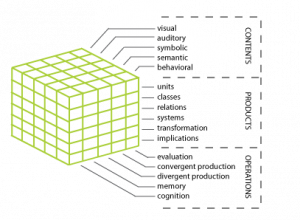 In Guilford’s Structure of Intellect (SI) theory, intelligence is viewed as comprising operations, contents, and products. There are 6 kinds of operations (cognition, memory recording, memory retention, divergent production, convergent production, evaluation), 6 kinds of products (units, classes, relations, systems, transformations, and implications), and 5 kinds of contents (visual, auditory, symbolic, semantic, behavioral). Since each of these dimensions is independent, there are theoretically 180 different components of intelligence.
In Guilford’s Structure of Intellect (SI) theory, intelligence is viewed as comprising operations, contents, and products. There are 6 kinds of operations (cognition, memory recording, memory retention, divergent production, convergent production, evaluation), 6 kinds of products (units, classes, relations, systems, transformations, and implications), and 5 kinds of contents (visual, auditory, symbolic, semantic, behavioral). Since each of these dimensions is independent, there are theoretically 180 different components of intelligence.
Guilford researched and developed a wide variety of psychometric tests to measure the specific abilities predicted by SI theory. These tests provide an operational definition of the many abilities proposed by the theory. Furthermore, factor analysis was used to determine which tests appeared to measure the same or different abilities.
Parenthetically, it is interesting to note that a major impetus for Guilford’s theory was his interest in creativity (Guilford, 1950). The divergent production operation identifies a number of different types of creative abilities.
Application
SI theory is intended to be a general theory of human intelligence. Its major application (besides educational research) has been in personnel selection and placement. Meeker (1969) examines its application to education.
Example
The following example illustrates three closely related abilities that differ in terms of operation, content, and product. Evaluation of semantic units (EMU) is measured by the ideational fluency test in which individuals are asked to make judgements about concepts. For example: “Which of the following objects best satisfies the criteria, hard and round: an iron, a button, a tennis ball or a lightbulb? On the other hand, divergent production of semantic units (DMU) would require the person to list all items they can think of that are round and hard in a given time period. Divergent production of symbolic units (DSU) involves a different content category than DMU, namely words (e.g., “List all words that end in ‘tion’). Divergent production of semantic relations (DMR) would involve the generation of ideas based upon relationships. An example test item for this ability would be providing the missing word for the sentence: “The fog is as ____ as sponge” (e.g., heavy, damp, full).
Principles
- Reasoning and problem-solving skills (convergent and divergent operations) can be subdivided into 30 distinct abilities (6 products x 5 contents).
- Memory operations can be subdivided into 30 different skills (6 products x 5 contents).
- Decision-making skills (evaluation operations) can be subdivided into 30 distinct abilities (6 products x 5 contents).
- Language-related skills (cognitive operations) can be subdivided into 30 distinct abilities (6 products x 5 contents).
References
- Guilford, J.P. (1950). Creativity. American Psychologist, 5, 444-454.
- Guilford, J.P. (1967). The Nature of Human Intelligence. New York: McGraw-Hill.
- Guilford, J.P. & Hoepfner, R. (1971). The Analysis of Intelligence. New York: McGraw-Hill.
- Guilford, J.P. (1982). Cognitive psychology’s ambiguities: Some suggested remedies. Psychological Review, 89, 48-59.
- Meeker, M.N. (1969). The Structure of Intellect. Columbus, OH: Merrill.
Related Websites
For more on Guilford and Structure of Intellect, see:
http://www.intelltheory.com/
http://www.soisystems.com
http://www.newworldencyclopedia.org/entry/J._P._Guilford